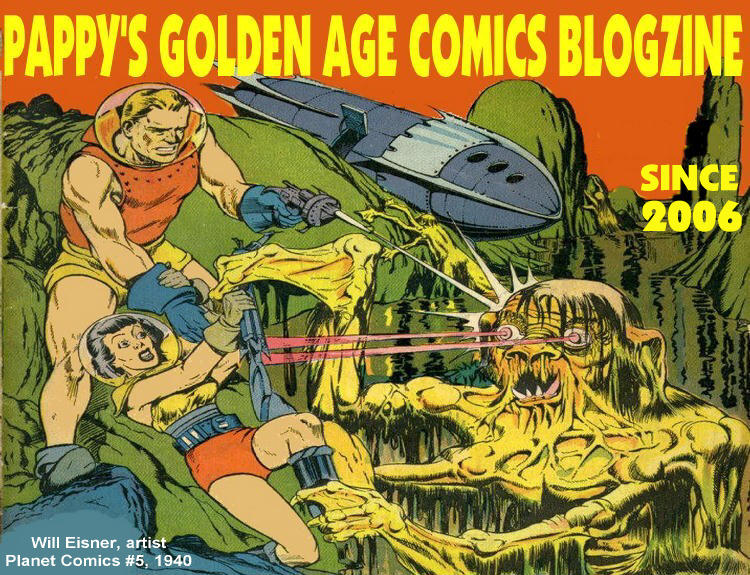 Number 89
Number 89Alley Oop And The Epics Of Homer!
I always thought of Alley Oop as the best comic strip I never got to see. As a kid in the 1950s I was aware of it. I'd seen some comic books here and there, so I was familiar enough with the character that when the popular song by the Hollywood Argyles came out in 1960 I knew what it referred to. What fascinated me about it was the science fiction idea of time travel.
V. T. Hamlin, created Alley Oop in the early 1930s, and it's still running today, almost three-fourths of a century later. Now that's time travel!
Oop has been popular enough for continuous publication, but didn't have the kind of distribution other popular strips had. It was syndicated by NEA, which wasn't King Features or Chicago Tribune, both of which had strips in thousands of newspapers, popular in all kinds of formats, from movies to radio to comic books. I have wondered if Alley Oop wouldn't have been twice as popular as many of the other comic strips of the era had it been given their syndication.
Reprints of Alley Oop have been sparse, but there have been some. My favorite reprints so far have been those of Kitchen Sink, but especially Dragon Lady Press in the mid-to-late 1980s. I don't know how hard these are to get now; I bought them off the stands from my local comic book shop when they came out. Dragon Lady was one of my favorite reprint publishers of the era, but may have been submerged by a comic book glut during that time.
 Besides the historical reprinting of the first Oop strips in #1, "The Legend Begins," the real historical (in both senses of the word) reprinting started with #2, "Enter The Time Machine," with the introduction of Doc Wonmug and his fantastic invention.
Besides the historical reprinting of the first Oop strips in #1, "The Legend Begins," the real historical (in both senses of the word) reprinting started with #2, "Enter The Time Machine," with the introduction of Doc Wonmug and his fantastic invention. Oop is plucked from the prehistoric world he had inhabited for the past six years of his strip's lifespan, and suddenly the whole world of plot ideas opened up. The sense of wonder the strip had for me was not in the caveman era sequences, but in the time travel elements.
Oop is plucked from the prehistoric world he had inhabited for the past six years of his strip's lifespan, and suddenly the whole world of plot ideas opened up. The sense of wonder the strip had for me was not in the caveman era sequences, but in the time travel elements.The first time travel sequence had a brief tease a few days before the strip did its abrupt turn in plot, a sequence where Ooola and Oop witness a camera, sent back through time, materialize and dematerialize before them.
 "Enter The Time Machine," and its follow-up in #3, "Oop Vs. Hercules," contain an uninterrupted 15-month story of Oop's adventures outside of his own time in Moo. Hamlin picked two epics, Homer's Iliad and Odyssey to kick off his new look for the strip. Oop and friends are in on the Trojan War, end up with Ulysses on his voyage home, then on their own odyssey with Hercules.
"Enter The Time Machine," and its follow-up in #3, "Oop Vs. Hercules," contain an uninterrupted 15-month story of Oop's adventures outside of his own time in Moo. Hamlin picked two epics, Homer's Iliad and Odyssey to kick off his new look for the strip. Oop and friends are in on the Trojan War, end up with Ulysses on his voyage home, then on their own odyssey with Hercules.Oop was a strip with humor, suspense, good storytelling, and above all, great artwork. As you can see from these two strips, Hamlin (and his assistants) didn't cheat the reader when it came to perspective or detailed drawings. Most artists just wouldn't go to that much trouble, not then, not now. Excellent drawing was a big part of the strip's appeal.
 Besides the perspective in drawing I like to put things into perspective. In 1939 comic strips were a major popular culture force. During World War II paper rationing caused strips to shrink and they've never stopped. In 1939, just before the start of their steady decline, they were full-size, and they were wonderful. Think of the titles of even a fraction of the popular strips of the era: The Phantom, Mandrake The Magician, Terry And The Pirates, Wash Tubbs, Li'l Abner, Dick Tracy, and the list goes on and on. It was almost an embarrassment of riches. As far as I'm concerned, Alley Oop held his own with any of the major comic strip players of the era.
Besides the perspective in drawing I like to put things into perspective. In 1939 comic strips were a major popular culture force. During World War II paper rationing caused strips to shrink and they've never stopped. In 1939, just before the start of their steady decline, they were full-size, and they were wonderful. Think of the titles of even a fraction of the popular strips of the era: The Phantom, Mandrake The Magician, Terry And The Pirates, Wash Tubbs, Li'l Abner, Dick Tracy, and the list goes on and on. It was almost an embarrassment of riches. As far as I'm concerned, Alley Oop held his own with any of the major comic strip players of the era.
No comments:
Post a Comment